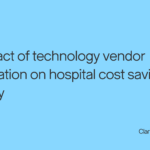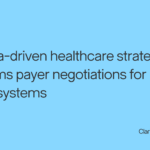As markets become ever more competitive, hospital diversification is becoming a top strategy for health system leaders. Health systems consolidation continues to accelerate, and hospitals continue to get bigger. But this really isn’t anything new, at least not in the last twenty years. What’s new is how complicated these partnerships are becoming. Hospital consolidation continues to accelerate across the U.S. in significant ways. Atrium Health and Advocate Aurora Health made a big splash when they merged into a $27 billion, 67-hospital health system in 2022 to become the fifth largest non-profit health system in the U.S. And there were more. Intermountain Healthcare and SCL Health merged into a 33-hospital system. The list continues. These are incredibly complex, multi-structured deals. They span your traditional horizontally structured mergers between health systems and IPAs to more innovative deal structures between insurance companies and hospitals to even newer hybrid models between providers and tech companies looking to capitalize on the opportunities that exist within healthcare. That’s why consolidation is a two-prong threat now. It’s not just that health systems are becoming bigger and bigger, they are becoming more and more diversified. The healthcare landscape continues to rapidly evolve in an already difficult economic environment. Not only does the cost of care continue to rise while payer reimbursement continues to decline, but we are now seeing new market entrants entering the healthcare ecosystems that don’t look like your traditional brick-and-mortar hospitals and insurance companies. Health systems acknowledge that these are stark realities that look to have staying power, and they are looking at new strategies that will future proof their systems tomorrow. In conversations we’ve had with Chief Strategy Officers across the U.S., the consistent strategy that has emerged is revenue diversification. Revenue diversification allows hospitals to grow their core business while securing future survival against environmental pressures. This article explores some of the rationale for why diversification is a good idea and some top diversification strategies major health systems are exploring. The reason for this diversification makes sense when you consider healthcare’s dynamic environment. Patients are becoming smarter consumers of their health and at greater price transparency, leading them away from the acute setting to more outpatient lower cost settings of care. The pandemic pushed Telehealth to the front, and while its use has declined since the pandemic, it is certainly here to stay. ASC investments proved worthwhile in fending off the continued encroachment of free-standing clinics. Value-based care service offerings became necessary investments for those systems looking to transition to value in partnership with commercial and MA payers. Perhaps what most executives are watching out for are disruptors like CVS and Walgreens who are inching their way up earlier into the patient journey. CVS and Walgreens understand – and have the localized footprint – to take advantage of the increasing need for accessible, low acuity care. Not only that, but they have the digital capacity and existing relationships to interact with these patients in ways that feel easy and understandable. It’s something to keep an eye on as it leaves room for innovation between health systems, retail pharmacies, and digital health companies looking to collaborate. So – what do all of these trends mean for you as a health system leader? Ultimately, it means health systems are becoming more sophisticated with multiple revenue streams. In the conversations we have had with multiple health system executives, many are moving beyond traditional growth strategies and investing in more innovative diversification strategies to both future-proof their systems from market threats and position themselves for strategic partnerships with payers and tech companies. In this series, we look at some of the top diversification trends we’re seeing across the U.S. and the consensus we’re hearing from Chief Strategy Officers across the board, starting with Telehealth. When the pandemic hit in 2020, almost overnight, Telehealth went from “what’s Telehealth?” to the preferred choice. And while Telehealth use has declined since the pandemic (as patients feel more comfortable interacting in-person), it shows extremely high staying power given the advantages around cost, accessibility, and convenience. The shift to Telehealth presents a remarkable opportunity for health systems looking to diversify their portfolio in ways that can increase their overall revenue; do it at higher margins than traditional in-person visits; and most importantly, improve the overall experience to the patients themselves. If you think about the patient journey, the PCP visit is often the start of their journey, which requires less specialization – making it the perfect candidate for Telehealth. Choosing a PCP is a critical first decision a patient makes when entering the health ecosystem; therefore, it’s a massive opportunity for health systems looking to capture new patients. But this decision is often hard to make when patients feel stuck in a complicated, difficult to access, difficult-to-navigate system. Telehealth simplifies that choice so by offering Telehealth, you increase your chance of getting new patients to come your way. There are many choices a patient needs to make as they continue thru their journey of care. Telehealth allows care navigators and coordinators to stay connected to their patients to ensure they understand their treatment plan with quick virtual check-ins. Engaged patients that feel cared for ultimately leads to patient satisfaction, increasing their likelihood of staying connected to your system. Additionally, access continues to be an issue in healthcare given staffing shortages. With long wait times still an issue, telehealth directly addresses many of these issues by giving doctors and patients an alternative, more efficient opportunity to meet. Compared to in-person visits, Telehealth is generally more accessible for both physician and patients given reduced driving times. It has shown to be more efficient, averaging 21 minutes per visit. This means that physicians can see more patients in the day but also during off-hours. It’s a win all around, especially given both access and staffing shortages across the U.S. Telehealth represents an opportunity for health systems to harness the power of technology to redesign how healthcare is delivered. By investing in these scaled solutions, health systems reduce traditional overhead costs that are squeezing health systems across the U.S. Additionally, it decreases the need for administrative staff given a reduction in administrative tasks that are cumbersome and time-consuming. In a study on sports medicine, a healthcare system saves, on average $24 a patient.Hospital consolidation is a two-prong threat now.
An Emerging Trend – Hospital Diversification
Reasons for Hospital Diversification
Telehealth is here to stay. And it’s a good investment.
How can Telehealth improve hospital revenues?
Telehealth can attract new patients.
Telehealth can help keep patients in network.
Telehealth allows physicians to see more patients.
Telehealth allows hospitals to provide care at a lower cost.
- Author Details






